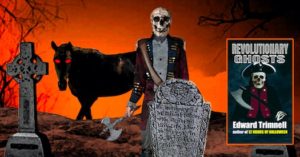The Sunoco station was a glass-paneled square building on a small parking lot. This was June, and the longest day of the year was fast approaching. At a little after 5:30 p.m., the sun was only beginning to edge toward the horizon. The windowed walls of the Sunoco station were lit up with reflected sunlight.
I parked at the edge of the parking lot, not at the gas pumps. I walked into the station, where a lone man around my father’s age was seated on a stool behind the counter. He was the only one minding the station. This he was doing while reading the sports section of the Cincinnati Enquirer.
I could only see the balding dome of the clerk’s head over the top of his newspaper. He had hair that was going grey, and receding from every possible angle.
The clerk had heard me come in, but he made a point of keeping his newspaper up. Yes, this was an hourly employee who was only putting in time. There were plenty of teenage employees like that, of course; but not every employee with a poor attitude was under the age of twenty-five. (Same thing now, as then.)
The store area of the gas station consisted of multiple rows of free-standing metal shelves. There was no signage to indicate what was shelved where. I supposed that I could have started at the front, and worked my way through every aisle and level of shelf. But I didn’t have that kind of time.
“Could you tell me where the oil is?” I asked. There might have been an edge to my voice. Maybe just a little one.
“Shelf closest to the window. Near the end of the aisle. Right side. Bottom shelf.”
The clerk delivered all of these instructions without looking up from his newspaper.
“Gee, thanks a lot,” I said.
The clerk lowered his newspaper for a second. He looked at me over his bifocal reading glasses. He pointedly glared.
Then he raised his newspaper again.
At least the oil was where he said it would be. The Sunoco station didn’t stock Pennzoil, but it did carry Quaker State. Just as good.
The clerk spoke to me as little as possible, and repeatedly glared, as he rang up my purchase and took my money.
What a dick, I thought, heading out to the parking lot, my quart of 10W-30 in hand.
I popped the hood and poured a quart of oil into the Bonneville. It was a maneuver with which I was well familiar by now. I removed a rag that I had placed in the footwell of the rear passenger seat. I used the rag to wipe the dipstick clean, then I checked to make sure that I had enough oil.
I did. For the time being. Luckily, it was a slow leak. I would be okay tonight. Possibly through tomorrow. By Monday I would likely need more oil.
I slammed the hood shut, and I happened to look over at the little patch of grass just beyond the parking lot, to my left.
And I saw the hoofprints.
A little chill went up my spine, defying the late-day heat.
The coincidences were stacking up.
I knelt down and examined the hoofprints in detail, just as I had done at the Pantry Shelf.
Once again, the hoofprints were slightly larger than normal. Growing up out on the fringes between the suburbs and the country, I knew what horse hoofprints were supposed to look like.
Not like this.
There was black gunk around the edges of each hoofprint. I could smell the foul odor, redolent of death and decay.
I was grappling with the weight of so many coincidences, trying to find a logical answer.
Maybe someone has been riding a horse, I thought—a normal Quarter Horse or Morgan—in the area.
If only a witness could tell me that he had seen a regular man or woman on horseback, their animal perfectly ordinary and mundane. If someone could tell me that, I could dismiss the black gunk around the edges of the indentations in the mud as unexplained but ignorable phenomena.
Because what was the alternative?
The alternative was that I had to think seriously about Harry Bailey’s article. About the Headless Horseman.
According to Harry Bailey’s article, the Headless Horseman had recently been seen in Pennsylvania. I knew my American geography, and I knew that Pennsylvania lay directly to the east of Ohio.
If the Headless Horseman had last been seen in Pennsylvania, and he was moving west…
I needed assurance of a logical explanation for the hoofprints.
But who could provide me with such assurance? If that horse was ridden this close to the Sunoco station, who might have seen it, and its perfectly human rider?
Who else, perhaps, but that man behind the counter of the Sunoco station, the man reading the sports section of the Cincinnati Enquirer?

